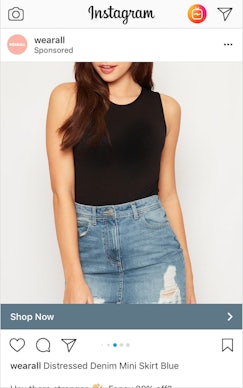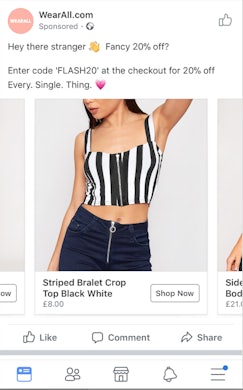Facebook defines Dynamic Ads as a way to “automatically promote your entire product catalogue across Facebook, Instagram and Audience Network without having to create thousands of individual ads.”
Facebook’s Dynamic Advertising function is a way to retarget users and potential customers of your website who have taken a specific action with products that would be deemed of interest to them. For example, showing users the specific products they have viewed online or added to their cart without purchasing.


Why Dynamic Ads you ask? They are completely automated, all you need to do is make sure you have a tracking pixel set up on site and a product catalogue uploaded to Facebook. Once you’ve created the ad parameters, Facebook will do the rest for you.
The content served to users through Dynamic Remarketing is completely tailored to the products they have been viewing. It’s as personalised as advertisers can possibly get at this stage, without physically calling out the users name in the ads. And the content each user is served is incredibly relevant to what they’ve been browsing or are looking to purchase.
Below are our top five top tips to ensure you’re getting the most out of your own Dynamic Remarketing campaigns;
1. Optimise for conversions
Your overall objective when using Dynamic ads should focus on the final stage of your strategy, the conversion. According to Facebook; “For Dynamic Ads, optimizing toward Conversions yields lower CPAs and higher ROI than when optimizing for other touch points, including Clicks” Sounds pretty good, right?
With Dynamic ads, you have the ability to retarget users based on multiple touch points that would ultimately lead you to validate that user as a considered purchaser. As a result, you want to retarget these customers with ads of the highest relevance to their previous experiences on your website, these types of ads simply can’t be built to the same quality manually.
2. Enable Placement Optimisation
Really going in on the whole “Let Facebook do the work” here. Set up your ads with automatic placements, these include:
Facebook Placements
- Feeds
- Instant Articles
- In-stream Videos
- Desktop Right Column
- Suggested Videos
Instagram Placements
- Feed
- Instagram Stories
Audience Network Placements
- Native, Banner and Interstitial
- In-stream videos
- Rewarded Videos
Messenger Placements
- Messenger Inbox
- Sponsored Messages
[Note: Not all placements are available at one given time]
Facebook will then optimise your ads to show where they’re likely to perform best and more often than one standard placement.
3. Segment your activity windows
Treat your Dynamic campaign the same as you would a standard conversion campaign – break down your activity windows by ad set. Depending on the volume of users in your audience, you could trial separating by recency of visit as follows;
- Activity – 1-7 Days
- Activity – 8-14 Days
- Activity – 15-30 Days
And so on. This allows you to focus on much granular audience sizes, gather data on the likelihood of a conversion based on recency of visit, and generally capture more customers per ad based on your budget.
4. Give Facebook Content Options
This is a very general point that should be carried out across dynamic and manual campaigns; try out a variety of different content variations. With dynamic ads, trial different copy variations, such as offers or calls to action. For instance, if you’re an eCommerce company, you could trial an ad with a ‘20% off voucher’ message versus a ‘free delivery’ offer messaging. Carrying out split testing with one variable at a time enable advertisers to test ad creative and copy with measurable results data.


5. Remarket everything (within your budget)
With dynamic ads, the world is pretty much your oyster, that saying there are multiple actions a potential customer can make on your site that can warrant a remarketing list. You can retarget the following customers using your Facebook pixel and dynamic remarketing:
Customers who have viewed a product, but not purchased
Allows you to promote your entire product catalogue to people who have viewed products in the past.
Customers who added to basket, but not purchased
Allows you to promote your entire product catalogue to customers who have abandoned their basket at checkout.
Up-sell specific products groups based on customers who viewed a specific product
This is where you can start building out specific product groups based on site categories in order to up-sell similar products to customers who have viewed specific products on site.
Cross-sell specific product groups based on customers who purchased a specific product
Similarly to up-selling, you can create specific product groups based on your site categories to try and cross-sell products to previous customers.
You also have the option to select a custom combination that includes an action and excludes and action. For example, viewed a product, but did not add to basket.
Finally, sit back, relax and watch the conversions roll in.





